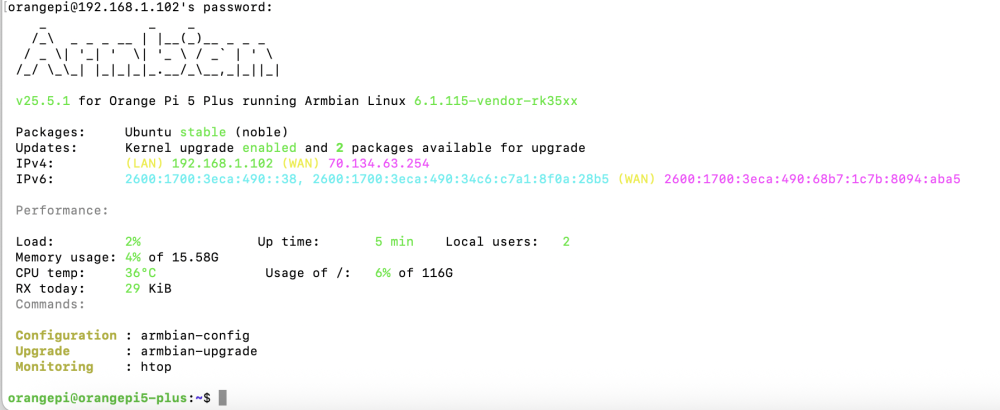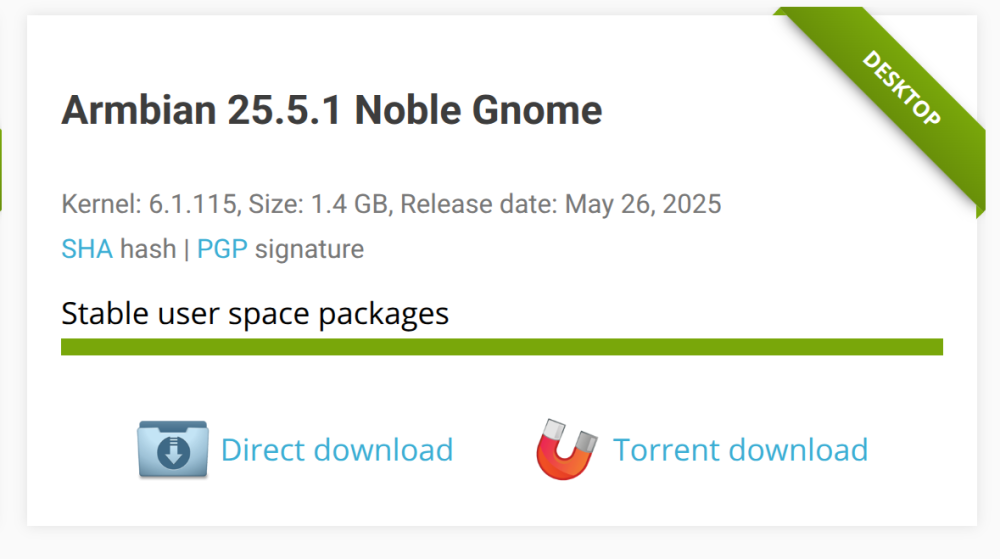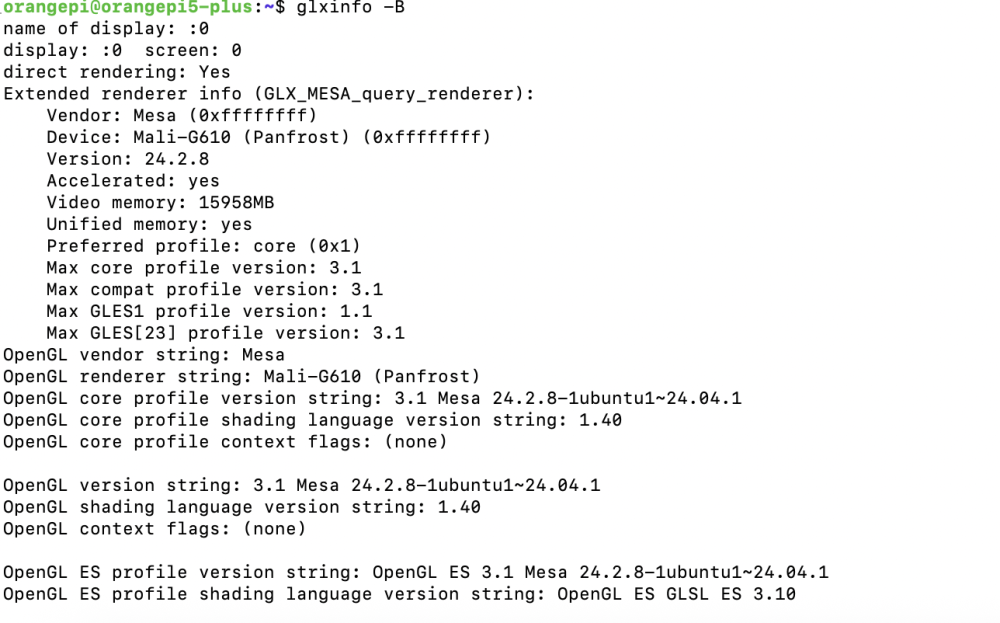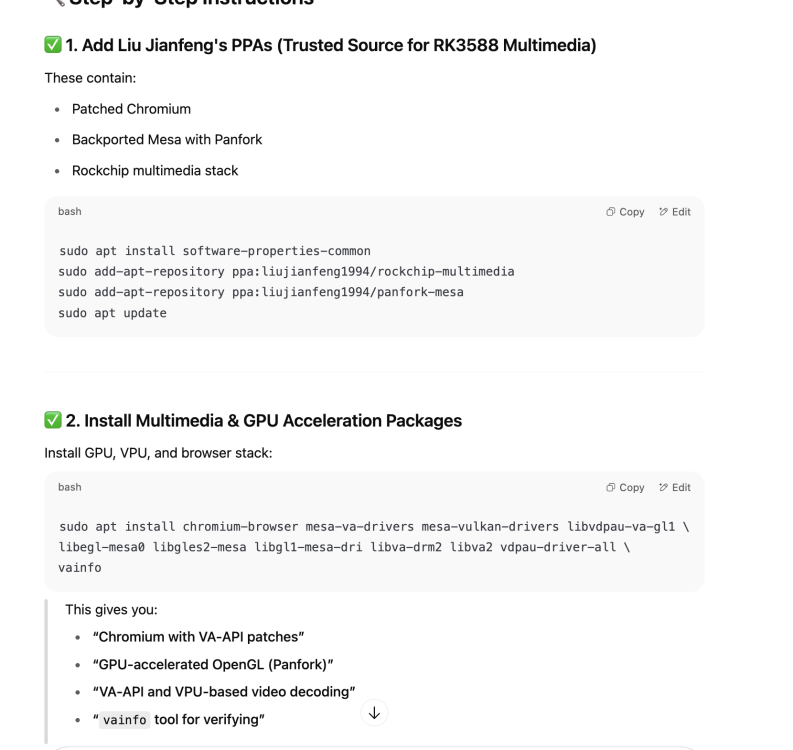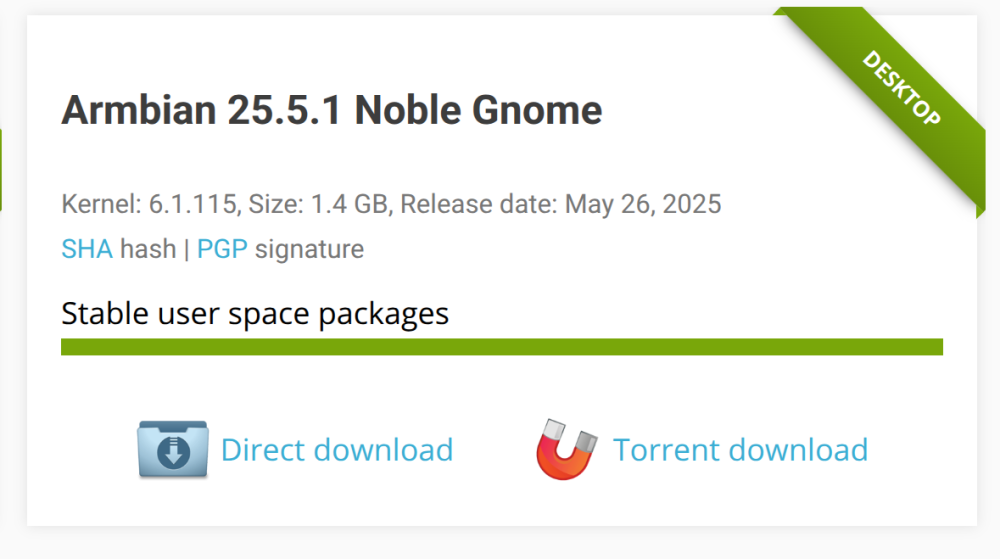All Activity
- Today
-
Knowing this means your options are to return the case+NVMe back to shop. Or do a cross-check; case with other NVME and NVME in M.2 slot of some other computer. But this is a typical Raspberry problem; storage via USB (SATA or NVME nowadays) easily leads to trouble. Mostly power related, but also many just the chipset in the adaptor. In case of Pi5, you could get an NVMe adaptor board, but also that is not always working out-of-the box. Only if you buy RPi adaptor and RPI NVME it should work out-of-the-box. Or other SBC that has M.2 slot already on the board.
-
@Werner Thanks let me try that But not sure why I hear that sound (check audio clip) and why screen os not full screen when OS loads. even if I disable the sound I still can here this weird sound. Thanks Manish Audio Clip (2025-07-30 10_47_47).m4a
-
Since about four weeks we encounter out of memory issues when building an Armbian image on GitHub with a customize-image.sh script. We had no big modifications on the build system since then, we have to rebuild from time to time to get the latest version of our application into the image. We already use a more powerful runner (32GB RAM, 8 cores). Our compile call: ./compile.sh \ BOARD=rockpi-4b \ BRANCH=edge \ RELEASE=bookworm \ KERNEL_CONFIGURE=no \ BUILD_MINIMAL=yes \ NETWORKING_STACK="network-manager" \ COMPRESS_OUTPUTIMAGE=xz \ KERNEL_BTF=no \ SHARE_LOG=yes Our build is based on the tag v25.8.0-trunk.260 Any ideas for this? Thanks in advance Florian
-
I did download it and burn a SD with it found it does have HDMI and Mali/Panfrost, which support Hardware acceleration, but it is make some weird noise as I started configuration. Not sure what is that So not sure why I need to patch it
-
./compile.sh BOARD=orangepi5-plus BRANCH=vendor RELEASE=noble ENABLE_EXTENSIONS=mesa-vpu or something like that for an image with this extension built-in. There is no method to install this on a existing system (yet).
-
Hi @Alex T Indeed the board seems to be dead not getting turned on at all. Even tried to boot with the secondary BIOS but not working. I managed to fit the new board in the older case so its perfectly being utilised.
-
Hi @orb First hing I thought the same if there is an issue with battery and unplugged it and tried turning on unfortunately no luck. Anyways, was not able to access my data hence move to another board and successfully restored all my data. But would love to revive this board.
-
Hmm, I tried running it on both mmcblk0boot* and got no output. I'll try running it on the full dump with -a to see if anything comes up. I'll try adding it to the config and go from there, see if it works. I'm not familiar with memory config and a lot of this stuff, but I am trying to learn all kinds of low level stuff and welcome the challenge!
-
@Igor: Hi Thanks for the response. I did get what you mean when you said "Vendor kernel 6.1.y with mesa-vpu extension https://github.com/armbian/os/blob/main/userpatches/targets-extensions.map#L58 (with patched Chromium) " Because I did try Above and I guess it is lacking either HDMI or GPU requirement. I will again test it. but now sure what you mean about extension. Do I need try to build that kernel version? Is below what you mean (from chat gpt) 🛠️ Option 1: Easiest Path — Use Prebuilt Stable Image Use this image (you already have it or download from Armbian): ✅ Armbian_25.5.1_Orangepi5-plus_bookworm_vendor_6.1.115_cinnamon-backported-mesa_desktop.img.xz Then, add the patched Chromium + mesa-vpu extension manually (I'll show you how in a moment).
-
@amazingfate can tell that. https://github.com/armbian/build/blob/main/config/boards/oneplus-kebab.conf#L3
-
You may examine this, diskpart, gfdisk, cfdisk, et.al., even is the cable connection clean? You may consider to check with raspianOS, as it is the best OS supporting rpi5.
-
I've successfully setup Armbian with home assistant preinstalled The image build command is ./compile.sh BOARD="rk3318-box" BRANCH=edge RELEASE=bookworm ENABLE_EXTENSIONS="ha" KERNEL_CONFIGURE="no" BUILD_MINIMAL="yes" I build on edge branch because only kernel after 6.15 can boot on rk3318 tv box, at this time it's 6.16.0rc3 Don't forget to add docker-ce and home assistant extension files to userpatches/extensions folder. After installation you need to cchange internet adapter manager from "Networking" to "Internet Manager" nmcli device set eth0 managed yes This is my prebuild version, use it at your own risk cause everyone on the internet might be the bad guy that want to hack your machine👻 Armbian-unofficial_25.08.0-trunk_Rk3318-box_bookworm_edge_6.16.0-rc3_minimal.img sha file attached Armbian-unofficial_25.08.0-trunk_Rk3318-box_bookworm_edge_6.16.0-rc3-homeassistant_minimal.img.txt Armbian-unofficial_25.08.0-trunk_Rk3318-box_bookworm_edge_6.16.0-rc3-homeassistant_minimal.img.sha
-
Hi, i have ordered complete new Hardware: - Raspberry 5 with 2GB, - USB-C NVME Case with RTL9201 chip and - NVME M.2 SSD: Kingspec NE-128 2280 with 128GB If I attached the M2 Case the SSD will not be detected (sda1) also not on an other PC. So now I don't know, what is defect (Case or SSD). I checked the Setting of the SSD in the case several times. Is there anything else, that I can do? Here some Logs: dmesg: [ 396.031067] usb 1-1: new high-speed USB device number 2 using xhci-hcd [ 396.175568] usb 1-1: New USB device found, idVendor=0bda, idProduct=9201, bcdDevice=f2.00 [ 396.175575] usb 1-1: New USB device strings: Mfr=1, Product=2, SerialNumber=3 [ 396.175579] usb 1-1: Product: RTL9201 [ 396.175583] usb 1-1: Manufacturer: Realtek [ 396.175586] usb 1-1: SerialNumber: 012345678999 [ 396.199296] usb-storage 1-1:1.0: USB Mass Storage device detected [ 396.203540] scsi host0: usb-storage 1-1:1.0 [ 397.222330] scsi 0:0:0:0: Direct-Access Realtek RTL9201 1.02 PQ: 0 ANSI: 6 [ 397.229650] sd 0:0:0:0: Attached scsi generic sg0 type 0 [ 397.234647] sd 0:0:0:0: [sda] Read Capacity(10) failed: Result: hostbyte=0x00 driverbyte=DRIVER_OK [ 397.234654] sd 0:0:0:0: [sda] Sense Key : 0x5 [current] [ 397.234659] sd 0:0:0:0: [sda] ASC=0x24 ASCQ=0x0 [ 397.235968] sd 0:0:0:0: [sda] 0 512-byte logical blocks: (0 B/0 B) [ 397.235974] sd 0:0:0:0: [sda] 0-byte physical blocks [ 397.237121] sd 0:0:0:0: [sda] Write Protect is off [ 397.237125] sd 0:0:0:0: [sda] Mode Sense: 37 00 00 08 [ 397.238266] sd 0:0:0:0: [sda] Write cache: disabled, read cache: enabled, doesn't support DPO or FUA [ 397.238589] sd 0:0:0:0: [sda] Attached SCSI disk lsusb -t: /: Bus 001.Port 001: Dev 001, Class=root_hub, Driver=xhci-hcd/2p, 480M |__ Port 001: Dev 002, If 0, Class=Mass Storage, Driver=usb-storage, 480M /: Bus 002.Port 001: Dev 001, Class=root_hub, Driver=xhci-hcd/1p, 5000M /: Bus 003.Port 001: Dev 001, Class=root_hub, Driver=xhci-hcd/2p, 480M |__ Port 002: Dev 002, If 0, Class=Human Interface Device, Driver=usbhid, 1.5M |__ Port 002: Dev 002, If 1, Class=Human Interface Device, Driver=usbhid, 1.5M /: Bus 004.Port 001: Dev 001, Class=root_hub, Driver=xhci-hcd/1p, 5000M lsblk: NAME MAJ:MIN RM SIZE RO TYPE MOUNTPOINTS sda 8:0 0 0B 0 disk mmcblk0 179:0 0 29G 0 disk ├─mmcblk0p1 179:1 0 256M 0 part /boot/firmware └─mmcblk0p2 179:2 0 28,4G 0 part /var/log.hdd / zram0 253:0 0 1,9G 0 disk [SWAP] zram1 253:1 0 50M 0 disk /var/log zram2 253:2 0 0B 0 disk Is there anything else, that I can do? Or should I ship back SSD and USB Case both? Regards Christian
-
Hello, everyone. Armbian website says OnePlus 8t is supported with "standard support" (here: https://www.armbian.com/oneplus-kebab/). I dont know what that includes as it is not very clear. Will one be able to do calls, send messages etc on that phone with Armbian (e.g. similar to sailfish os or ubuntu touch on their respective supported devices). I am basically asking if cellular, wifi, camera etc works fine.
-
https://docs.armbian.com/Process_Contribute/#adding-a-new-board
-
Heya, No issue here with a rock 5b plus with rkmppenc v0.15 under kernel 6.1.115 on armbian 25.5.1 using HEVC transcoding: acas@rock-5b-plus:~$ rkmppenc -c hevc --preset best --audio-codec aac --vbr 700 -i ~hts/recordings/foo.ts -o ts.mkv -------------------------------------------------------------------------------- ts.mkv -------------------------------------------------------------------------------- [h264 @ 0xaaab23a61de0] non-existing PPS 0 referenced arm_release_ver: g24p0-00eac0, rk_so_ver: 6 rkmppenc (aarch64) 0.14 (r493) by rigaya, Apr 5 2025 09:08:50 (gcc 13.3.0/Linux) OS: Armbian 25.5.2 noble (6.1.115-vendor-rk35xx) aarch64 CPU: Cortex-A76 aarch64 (4P+4E,8C/8T) Input Info: avmpp: H.264/AVC, 1920x1080, 25/1 fps Output: H.265/HEVC main @ Level auto (main tier) 1920x1080p 1:1 25.000fps (25/1fps) avwriter: hevc, #1:mp2/stereo -> aac/stereo/128kbps, #2:aac_latm/stereo -> aac/stereo/128kbps => matroska Quality: best VBR: 700 kbps Max bitrate: 875 kbps QP: Min: 0, Max: 51 GOP Len: 300 frames CHECKPTS: check_pts(1/1): timestamp of video frame is smaller than previous frame, changing pts: -16 -> 2 (previous pts 0). CHECKPTS: check_pts(2/2): timestamp of video frame is smaller than previous frame, changing pts: -24 -> 4 (previous pts 2). CHECKPTS: check_pts(3/3): timestamp of video frame is smaller than previous frame, changing pts: -8 -> 6 (previous pts 4). ^C.8%] 8506 frames: 496.29 fps, 743 kbps, remain 0:05:37, est out size 624.3MB Encoding aborted. encoded 8917 frames, 489.43 fps, 743.66 kbps, 31.62 MB encode time 0:00:18, CPULoad: 0.0% frame type IDR 30 frame type I 30, avgQP 26.73, total size 1.22 MB frame type P 8887, avgQP 30.84, total size 30.40 MB Finished with error in rkmppenc. From looking at your logs, looks like a Device TRee issue - failed to identify key hardware parameters by the looks of it for some reason - change in boot settings? regards Andrew
-

Ugoos AM9 s905x5 ARMBIAN build
Roman Fedorenko replied to Roman Fedorenko's topic in Amlogic CPU Boxes
-
TI SK-AM62A7 is not supported by Armbian, can I use Armbian and create a custom debian based image for TI SK-AM62A7. Support for TI SK-AM62 is there. Kindly guide me on how can I start building my custom image for TI-SK AM62A7.
-
That should be O.K. too.
-
tl;dr; This "only" difference is huge - modern kernel hw specific code is pretty much written from scratch, feature by feature. Not to mention differences in general areas between kernel 6.1 and 6.12, low level boot loader is also usually different. Further reading: https://docs.armbian.com/User-Guide_FAQ/#why-things-stop-working
-
Vendor kernel 6.1.y with mesa-vpu extension https://github.com/armbian/os/blob/main/userpatches/targets-extensions.map#L58 (with patched Chromium) is the only way to come close to what you want. Only this:
-
Hi Guys, Here is my requirements for an electron app running Armbian OS on orangepi5 plus to support: Need GPU hardware acceleration to play video Need HDMI audio And possible NPU support. I really need help, I did lots of custom builds to find solution support all my above requirement and I found Armbian-unofficial_25.08.0-trunk_Orangepi5-plus_noble_edge_6.16.0-rc7_cinnamon_desktop.img. But my electron add crashes after running say 8 hrs or so, means it is not very stable for us [83833:0723/100030.362659:ERROR:ssl_client_socket_impl.cc(877)] handshake failed; returned -1, SSL error code 1, net_error -202 [83790:0723/101648.420086:ERROR:zygote_communication_linux.cc(296)] Failed to send GetTerminationStatus message to zygote [83790:0723/101648.423629:ERROR:network_service_instance_impl.cc(612)] Network service crashed, restarting service. [83790:0723/101648.434571:ERROR:zygote_communication_linux.cc(296)] Failed to send GetTerminationStatus message to zygote [83790:0723/101648.439553:ERROR:gpu_process_host.cc(947)] GPU process launch failed: error_code=1002 [83790:0723/101648.440252:ERROR:gpu_process_host.cc(947)] GPU process launch failed: error_code=1002 [83790:0723/101648.440865:ERROR:gpu_process_host.cc(947)] GPU process launch failed: error_code=1002 [83790:0723/101648.441459:ERROR:gpu_process_host.cc(947)] GPU process launch failed: error_code=1002 [83790:0723/101648.442003:ERROR:gpu_process_host.cc(947)] GPU process launch failed: error_code=1002 [83790:0723/101648.442527:ERROR:gpu_process_host.cc(947)] GPU process launch failed: error_code=1002 [83790:0723/101648.443115:ERROR:gpu_process_host.cc(947)] GPU process launch failed: error_code=1002 [83790:0723/101648.443586:ERROR:gpu_process_host.cc(947)] GPU process launch failed: error_code=1002 [83790:0723/101648.444045:ERROR:gpu_process_host.cc(947)] GPU process launch failed: error_code=1002 [83790:0723/101648.444060:FATAL:gpu_data_manager_impl_private.cc(420)] GPU process isn't usable. Goodbye. I did try other custom build as below, but either they are lacking HDMI audio or GPU hardware acceleration. Please help with this. Thanks Manish
-
Welcome to the forum! Your project sounds really interesting and practical, especially for optimizing fleet fuel usage. For an Armbian-based solution, Python is usually the best starting point. It offers great flexibility, extensive libraries, and good community support. Using Python with libraries like Matplotlib for visualization and Pandas for data handling would make it easier to process sensor data and create useful charts. Plus, Python scripts can easily be integrated into your workflow, whether as standalone scripts or through lightweight web interfaces (Flask or Dash, for example). Bash with awk might be lightweight but can quickly get complicated as your project grows—especially when you need calculations and data visualization. As for sensor integration, make sure to check the compatibility and communication protocol (I2C, SPI, UART) of your fuel sensors with Orange Pi. Sometimes the challenge is not only reading accurate data but also filtering out noise and handling sensor calibration. Regarding dashboards, if Grafana feels too heavy or lacking in fuel-specific functions, you might consider building a custom Python dashboard or integrating with lightweight web frameworks that allow tailored features like a dedicated fuel calculator. Looking forward to seeing your startup script and how your project evolves!
- Yesterday
-

Rupa X88 Pro 13 - RK3528 board with images
fedes_gl replied to fedes_gl's topic in Rockchip CPU Boxes
I saw the release of linux kernel 6.16 with initial support for Rockchip RK3528. I hope this update makes more viable to run and configura Armbian on this board 😀 -
Have you tried running sunxi-fw with the boot image you used to extract the dts? The boot image you posted is a U-Boot FIT image. It doesn't have the dram information we are looking for. I believe mmcblk0boot0 is the correct boot image but the one you uploaded didn't work with sunxi-fw. Also, I found this in your dts. Maybe these settings will work. To make sure these settings are correct I prefer to get the dram settings using the sunxi-fw tool. dram { compatible = "allwinner,dram"; clocks = <0xda>; clock-names = "pll_ddr"; dram_clk = <0x288>; dram_type = <0x07>; dram_zq = <0x3f3fdd>; dram_odt_en = <0x9988eeee>; dram_para1 = <0x30fa>; dram_para2 = <0x1000>; dram_mr0 = <0x00>; dram_mr1 = <0xc3>; dram_mr2 = <0x06>; dram_mr3 = <0x01>; dram_tpr0 = <0x00>; dram_tpr1 = <0x00>; dram_tpr2 = <0x00>; dram_tpr3 = <0x00>; dram_tpr4 = <0x00>; dram_tpr5 = <0x00>; dram_tpr6 = <0x2fc08080>; dram_tpr7 = <0x00>; dram_tpr8 = <0x00>; dram_tpr9 = <0x00>; dram_tpr10 = <0x402f3379>; dram_tpr11 = <0xd100b0f>; dram_tpr12 = <0x11131113>; dram_tpr13 = <0x80060>; linux,phandle = <0x183>; phandle = <0x183>; device_type = "dram"; dram_dx_odt = <0x6060606>; dram_dx_dri = <0xd0d0d0d>; dram_ca_dri = <0x1919>; dram_mr4 = <0x00>; dram_mr5 = <0x00>; dram_mr6 = <0x00>; dram_mr11 = <0x00>; dram_mr12 = <0x00>; dram_mr13 = <0x00>; dram_mr14 = <0x00>; dram_mr16 = <0x00>; dram_mr17 = <0x00>; dram_mr22 = <0x00>; }; The dram clock is in hex you'll need to convert this value to decimal. https://www.rapidtables.com/convert/number/hex-to-decimal.html

.thumb.jpg.59cba04974b8104129849d2dd7baeeb4.jpg)
